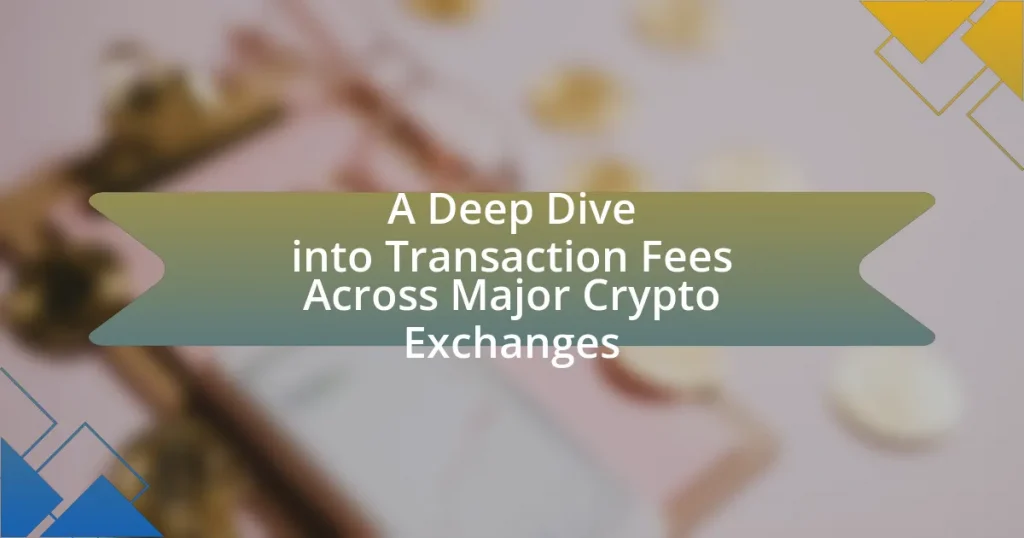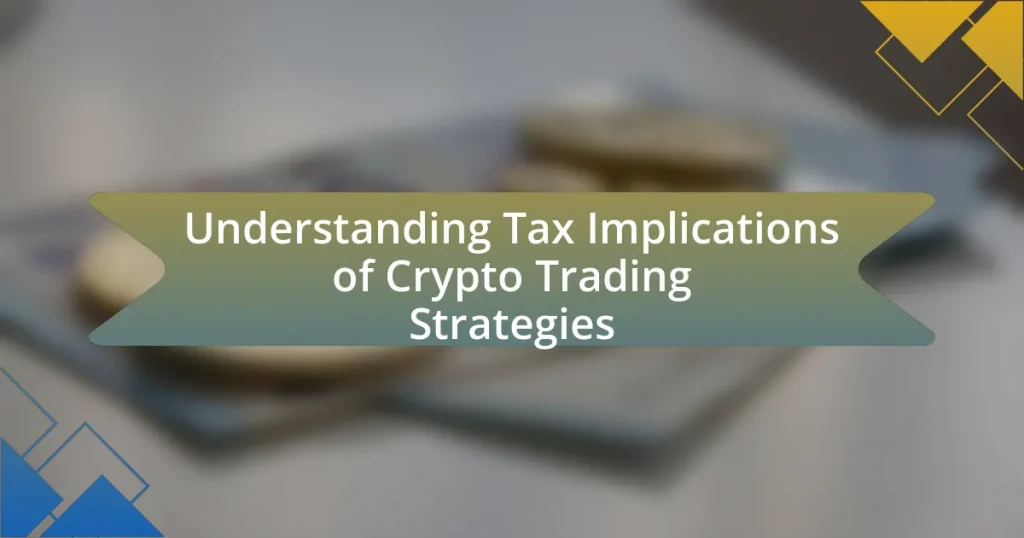Transaction fees in crypto exchanges are essential charges incurred during the buying, selling, or trading of cryptocurrencies, varying significantly across platforms and transaction types. This article provides a comprehensive overview of how transaction fees are calculated, the factors influencing these fees, and the differences between centralized and decentralized exchanges. It also explores the various types of fees, including trading, withdrawal, and deposit fees, while offering strategies for traders to optimize their costs. Additionally, the role of exchange liquidity and trading volumes in fee structures is examined, along with tools and resources available for tracking and comparing transaction fees across major exchanges.
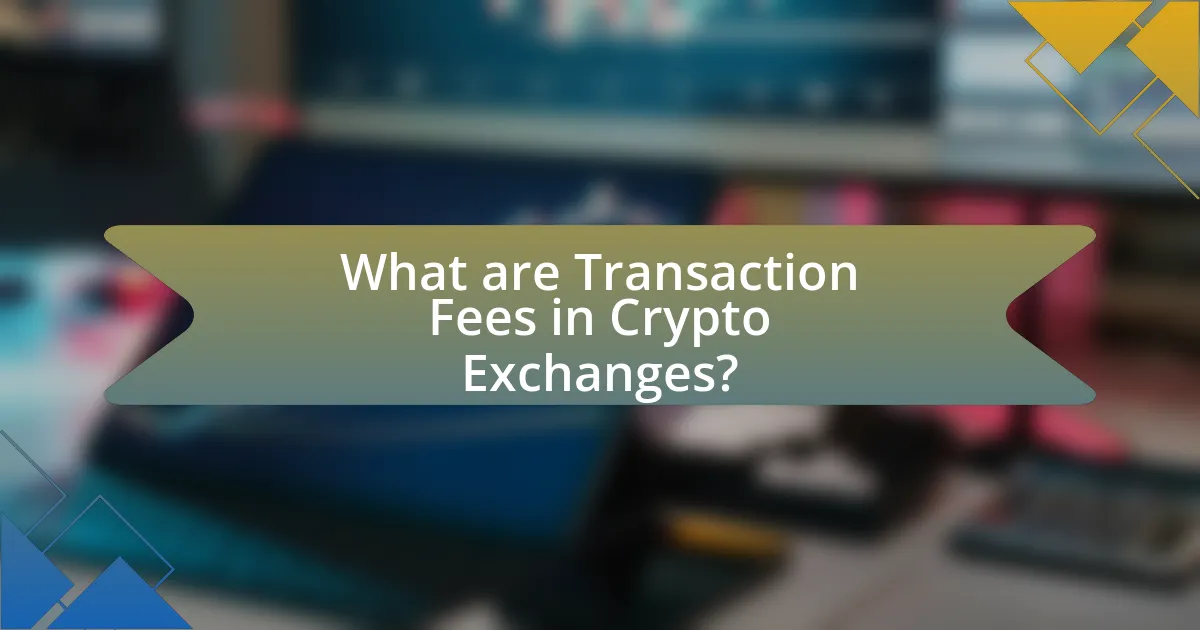
What are Transaction Fees in Crypto Exchanges?
Transaction fees in crypto exchanges are charges incurred when users buy, sell, or trade cryptocurrencies on these platforms. These fees can vary significantly based on the exchange, the type of transaction, and the payment method used. For instance, centralized exchanges often charge a percentage of the transaction amount, typically ranging from 0.1% to 0.5%, while decentralized exchanges may have different fee structures, including gas fees for network transactions. The rationale behind these fees is to cover operational costs, incentivize liquidity providers, and maintain the network’s security.
How are transaction fees calculated on major crypto exchanges?
Transaction fees on major crypto exchanges are typically calculated based on a percentage of the transaction amount, a flat fee, or a combination of both. For instance, many exchanges charge a fee that ranges from 0.1% to 0.5% of the total transaction value, while others may impose a fixed fee for smaller transactions. Additionally, some exchanges utilize a tiered fee structure where fees decrease as trading volume increases, incentivizing higher trading activity. This fee structure is often influenced by market conditions, the specific cryptocurrency being traded, and the exchange’s operational costs.
What factors influence the calculation of transaction fees?
Transaction fees are influenced by several key factors, including network congestion, transaction size, and the fee structure of the specific cryptocurrency. Network congestion occurs when there are many transactions waiting to be processed, leading to higher fees as users compete to have their transactions prioritized. Transaction size, measured in bytes, affects fees because larger transactions require more computational resources to process. Additionally, different cryptocurrencies have varying fee structures; for instance, Bitcoin uses a dynamic fee model based on supply and demand, while Ethereum’s fees can fluctuate based on gas prices determined by network activity. These factors collectively determine the final transaction fee a user must pay.
How do different cryptocurrencies affect transaction fees?
Different cryptocurrencies affect transaction fees based on their underlying technology, network congestion, and consensus mechanisms. For instance, Bitcoin typically has higher transaction fees during peak usage due to its limited block size and proof-of-work consensus, which can lead to slower transaction processing times. In contrast, Ethereum’s fees can fluctuate significantly based on network demand and the complexity of smart contracts, with average fees reaching over $50 during high congestion periods in 2021. Additionally, cryptocurrencies like Ripple and Stellar are designed for low-cost transactions, often resulting in fees that are fractions of a cent, making them more efficient for cross-border payments. These variations illustrate how the design and operational characteristics of each cryptocurrency directly influence their transaction fee structures.
Why do transaction fees vary across different exchanges?
Transaction fees vary across different exchanges due to factors such as the exchange’s operational costs, liquidity levels, and the specific trading pairs offered. Each exchange has unique pricing structures influenced by its business model; for instance, centralized exchanges often charge higher fees to cover security and maintenance costs, while decentralized exchanges may have lower fees due to reduced overhead. Additionally, liquidity impacts fees, as exchanges with higher trading volumes can afford to charge lower fees to attract more users. For example, Binance, known for its high liquidity, offers lower fees compared to smaller exchanges that may charge more to sustain their operations.
What role does exchange liquidity play in fee variation?
Exchange liquidity significantly influences fee variation by determining the ease of executing trades without causing substantial price changes. High liquidity typically leads to lower transaction fees because it allows for quicker and more efficient trades, reducing the costs associated with slippage and market impact. Conversely, low liquidity can result in higher fees as traders may face larger spreads and increased costs to execute their orders. For instance, a study by the Bank for International Settlements found that exchanges with higher liquidity tend to have tighter bid-ask spreads, which directly correlates with lower trading fees. Thus, the level of liquidity in an exchange is a critical factor in shaping its fee structure.
How do trading volumes impact transaction fees on exchanges?
Trading volumes significantly impact transaction fees on exchanges by influencing the liquidity and pricing structure of trades. Higher trading volumes typically lead to lower transaction fees because exchanges can spread their operational costs over a larger number of trades, thereby reducing the fee per transaction. For instance, exchanges often implement tiered fee structures where users with higher trading volumes qualify for lower fees. According to a report by CoinMarketCap, exchanges like Binance and Coinbase Pro offer reduced fees for users who trade above certain volume thresholds, demonstrating that increased activity can lead to cost savings for traders.
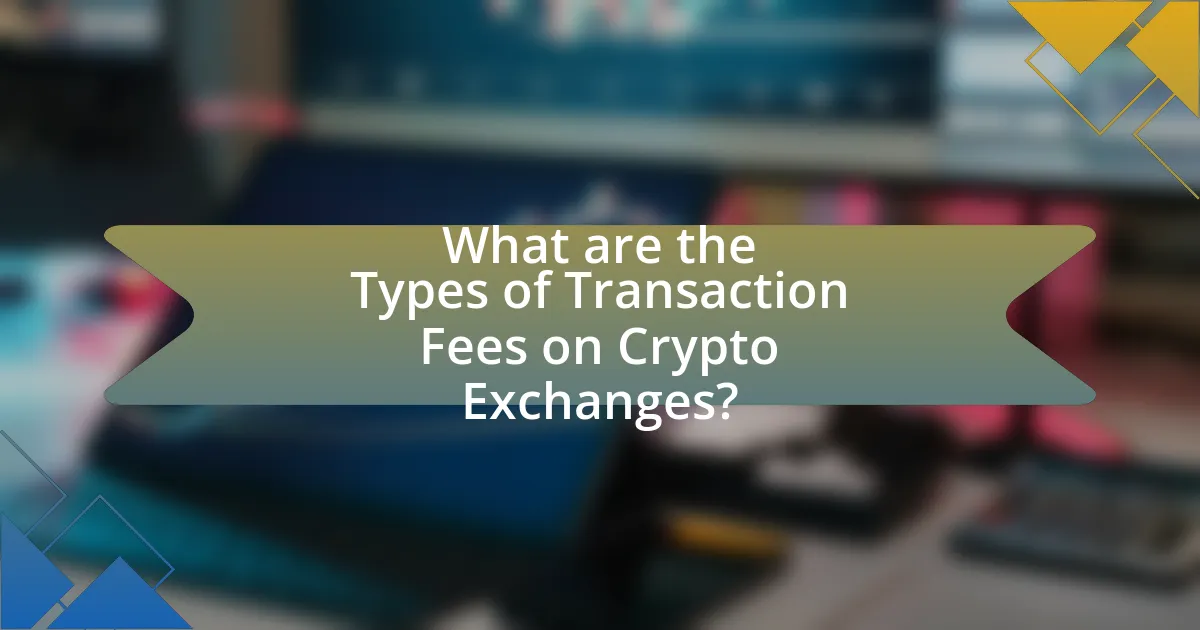
What are the Types of Transaction Fees on Crypto Exchanges?
The types of transaction fees on crypto exchanges include trading fees, withdrawal fees, deposit fees, and network fees. Trading fees are charged for executing buy or sell orders and can vary based on the exchange’s fee structure, often categorized as maker or taker fees. Withdrawal fees are incurred when transferring funds from the exchange to an external wallet, and these fees can differ based on the cryptocurrency being withdrawn. Deposit fees may apply when transferring funds into the exchange, although many exchanges offer free deposits for certain payment methods. Network fees, also known as miner fees, are paid to the blockchain network for processing transactions and can fluctuate based on network congestion. These fee structures are essential for users to understand, as they directly impact the overall cost of trading on crypto exchanges.
What are the common types of fees associated with crypto transactions?
The common types of fees associated with crypto transactions include trading fees, withdrawal fees, deposit fees, and network fees. Trading fees are charged by exchanges for executing buy or sell orders, typically expressed as a percentage of the transaction amount. Withdrawal fees are incurred when transferring cryptocurrency from an exchange to an external wallet, varying based on the asset and exchange policies. Deposit fees may apply when funding an account, especially through credit cards or certain payment methods. Network fees, also known as miner fees, are paid to miners for processing transactions on the blockchain and fluctuate based on network congestion. These fees are essential for maintaining the functionality and security of cryptocurrency transactions.
How do maker and taker fees differ in crypto trading?
Maker and taker fees in crypto trading differ primarily in their application based on the type of order executed. Maker fees are charged to traders who provide liquidity to the market by placing limit orders that are not immediately matched, while taker fees apply to traders who remove liquidity by placing market orders that are executed against existing orders. For example, on exchanges like Binance, maker fees are typically lower than taker fees, reflecting the incentive for traders to add liquidity to the market. This fee structure encourages a more stable trading environment by rewarding those who contribute to market depth.
What are withdrawal and deposit fees, and how do they work?
Withdrawal and deposit fees are charges imposed by financial institutions or cryptocurrency exchanges for processing transactions involving the transfer of funds into or out of an account. These fees typically vary based on the platform, the method of transaction, and the amount being transferred.
For deposits, fees may be applied when funds are added to an account, often depending on the payment method used, such as credit cards or bank transfers. For withdrawals, fees are charged when funds are taken out of an account, which can also vary based on the withdrawal method, such as cryptocurrency transfers or bank withdrawals.
For example, a cryptocurrency exchange may charge a flat fee for withdrawals, or a percentage of the transaction amount, which is common in the industry. According to a report by CoinMarketCap, average withdrawal fees can range from $0.10 to $5, depending on the cryptocurrency and exchange. These fees are essential for covering the operational costs of processing transactions and maintaining the platform’s infrastructure.
How do transaction fees differ between centralized and decentralized exchanges?
Transaction fees on centralized exchanges are typically higher than those on decentralized exchanges. Centralized exchanges often charge fees that range from 0.1% to 0.5% per trade, which can include maker and taker fees, as well as withdrawal fees. In contrast, decentralized exchanges usually have lower fees, often around 0.1% or less, primarily due to the absence of intermediaries and lower operational costs. For example, Uniswap, a popular decentralized exchange, charges a flat fee of 0.3% per trade, while Binance, a centralized exchange, has varying fees based on trading volume and user tier. This difference in fee structures is largely attributed to the operational models of each type of exchange, where centralized exchanges require more infrastructure and regulatory compliance, leading to higher costs.
What are the advantages and disadvantages of fees on centralized exchanges?
Fees on centralized exchanges provide both advantages and disadvantages. The primary advantage is that fees contribute to the operational sustainability of the exchange, allowing for continuous development, security enhancements, and customer support. For instance, exchanges like Binance and Coinbase generate significant revenue through trading fees, which can be reinvested into improving their platforms and services.
Conversely, the main disadvantage is that high fees can deter users from trading, particularly for small transactions, as they may reduce overall profitability. For example, a trading fee of 0.5% on a $100 transaction results in a $0.50 cost, which can be substantial for frequent traders or those with smaller capital. Additionally, users may seek alternatives with lower fees, impacting the exchange’s market share.
How do decentralized exchanges structure their transaction fees?
Decentralized exchanges (DEXs) typically structure their transaction fees as a percentage of the trade value, often ranging from 0.1% to 0.3%. This fee is charged to users for executing trades on the platform and is usually paid in the native cryptocurrency of the exchange. Additionally, some DEXs implement a liquidity provider fee, which rewards users who contribute liquidity to the trading pools, further incentivizing participation. For example, Uniswap charges a standard fee of 0.3% on trades, which is distributed to liquidity providers, demonstrating a clear model of fee distribution that supports the ecosystem’s sustainability.
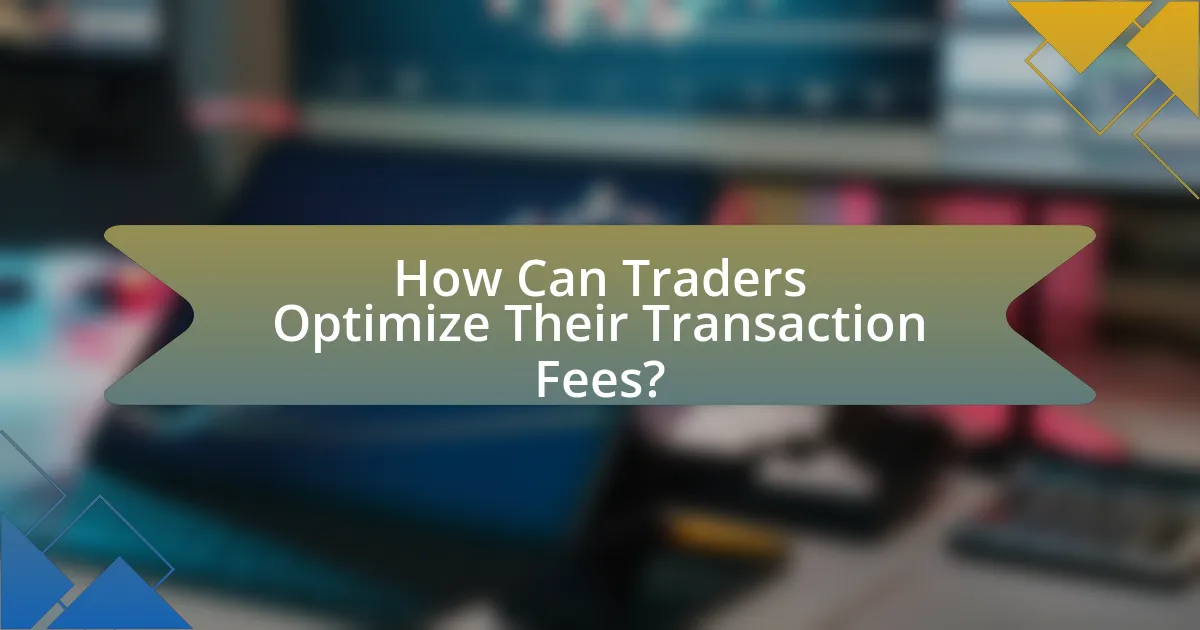
How Can Traders Optimize Their Transaction Fees?
Traders can optimize their transaction fees by selecting exchanges with lower fee structures, utilizing fee discounts through native tokens, and timing their trades to avoid peak network congestion. For instance, exchanges like Binance offer reduced fees when users pay with BNB, their native cryptocurrency. Additionally, trading during off-peak hours can lead to lower fees due to reduced demand on the network. According to a report by CoinMarketCap, transaction fees can vary significantly across platforms, with some exchanges charging as low as 0.1% per trade, while others may charge up to 0.5%. By strategically choosing platforms and timing, traders can effectively minimize their transaction costs.
What strategies can traders use to minimize transaction fees?
Traders can minimize transaction fees by utilizing strategies such as choosing exchanges with lower fee structures, trading during off-peak hours, and using limit orders instead of market orders. Selecting exchanges like Binance or Kraken, which offer competitive fee schedules, can significantly reduce costs. Trading during off-peak hours often results in lower fees due to reduced network congestion. Additionally, limit orders typically incur lower fees compared to market orders, as they allow traders to specify the price at which they are willing to buy or sell, thus avoiding higher costs associated with immediate execution. These strategies are effective in managing and reducing transaction fees in the crypto trading landscape.
How does choosing the right exchange impact transaction fees?
Choosing the right exchange significantly impacts transaction fees due to variations in fee structures among different platforms. Each exchange may charge different fees for trading, withdrawals, and deposits, which can range from a flat rate to a percentage of the transaction amount. For instance, some exchanges like Binance offer lower trading fees, often around 0.1%, while others may charge up to 0.5% or more. Additionally, exchanges may have different policies regarding withdrawal fees, which can further affect the overall cost of transactions. Therefore, selecting an exchange with favorable fee structures can lead to substantial savings, especially for high-volume traders.
What timing strategies can help reduce fees during trading?
To reduce fees during trading, traders can implement timing strategies such as trading during off-peak hours and utilizing limit orders. Trading during off-peak hours, typically when market activity is lower, can lead to reduced fees as exchanges often have lower transaction costs during these times due to decreased demand. For instance, many exchanges offer lower fees during specific hours to encourage trading when volume is low. Additionally, using limit orders instead of market orders can help minimize fees, as limit orders allow traders to set their desired price, potentially avoiding higher fees associated with immediate market orders. This strategy is supported by the fact that exchanges often charge lower fees for limit orders compared to market orders, which can incur higher costs due to slippage.
What tools and resources are available for tracking transaction fees?
Various tools and resources are available for tracking transaction fees across major crypto exchanges, including websites, applications, and APIs. Websites like CoinMarketCap and CryptoCompare provide real-time data on transaction fees for different cryptocurrencies, allowing users to compare costs across exchanges. Additionally, blockchain explorers such as Etherscan and Blockchair offer insights into transaction fees by displaying historical fee data and current network conditions. Furthermore, some exchanges have built-in fee calculators that help users estimate costs before executing trades. These resources are essential for traders to make informed decisions regarding transaction costs in the cryptocurrency market.
How can fee comparison websites assist traders in decision-making?
Fee comparison websites assist traders in decision-making by providing transparent and comprehensive information about transaction fees across various crypto exchanges. These platforms enable traders to easily compare fees, including trading, withdrawal, and deposit costs, which can significantly impact overall profitability. For instance, a study by CoinMarketCap revealed that trading fees can vary widely, with some exchanges charging as low as 0.1% while others may charge up to 0.5%. By utilizing fee comparison websites, traders can identify the most cost-effective exchanges for their trading strategies, ultimately leading to more informed and financially sound decisions.
What role do fee calculators play in optimizing trading costs?
Fee calculators play a crucial role in optimizing trading costs by providing traders with precise estimates of transaction fees associated with their trades. These tools enable users to input various parameters, such as trade size and exchange type, to calculate the total costs involved, allowing for informed decision-making. For instance, a study by the Cambridge Centre for Alternative Finance highlights that traders who utilize fee calculators can reduce their overall trading expenses by up to 20% by selecting the most cost-effective exchanges and trading strategies. This optimization is essential in the highly competitive landscape of crypto trading, where even minor fee differences can significantly impact profitability.










